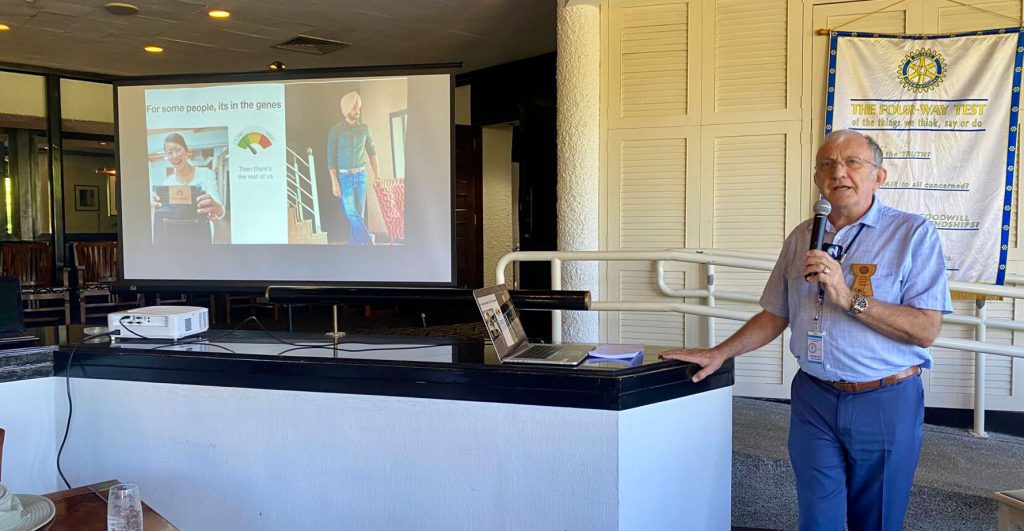Rotary guest highlights risk factors for heart attacks

Dr. Peter W. Gregor, a cardiologist at the Commonwealth Healthcare Corp. presents the risk factors of heart attacks, which include diabetes and a high diet of high-fructose corn syrup, during the Tuesday luncheon of the Rotary Club of Saipan at the Giovanni’s restaurant of the Hyatt Regency Saipan. (LEIGH GASES)
It used to be that smoking was the biggest risk factor for heart attacks, especially in the ’70s, but that changed in the latter part of the ’90s, when a new risk-factor emerged, called metabolic syndrome, that leads to adult-onset diabetes.
This was the highlight of a presentation Dr. Peter W. Gregor did to the Rotary Club of Saipan last Tuesday at their weekly meeting at the Hyatt Regency Saipan’s Italian restaurant, Giovanni’s. Gregor, who is a cardiologist at the Commonwealth Healthcare Corp. and is a physician going on 50 years now, presented on the risk factor of heart attacks and the changing risk factors over four decades, with a focus on diet.
For some people, Gregor said, heart disease either is or is not in the genes. And as a general rule, he said, the Japanese do not get coronary artery disease—with one exception, the sumo wrestlers, whose diets are similar to that of an average American.
Coronary artery disease causes most heart attacks due to one or more of the heart arteries being blocked by plaques, which in turn narrows the arteries, reducing blood flow to the heart.
In the ’70s, Gregor said, smoking was one of the major risk factors, but with the proliferation of no-smoking ads and the general success of the no-smoking campaign, “smoking as risk for coronary disease has receded considerably.”
Then, in 1998, there was a new disease called metabolic syndrome. It’s all the consequences of obesity rolled into one—hypertension, bad cholesterol, and pre-diabetes, which is a major risk factor for diabetes. These conditions increased the probability of coronary artery disease to 50%.
This disease, which leads to Type II diabetes, is accelerated by the high consumption of fructose, or high fructose corn syrup, which can be found in almost all foods today.
In Gregor’s presentation, he said the intake of high-fructose corn syrup rose more than 10,000% per person from 1970 to 2005, paralleling skyrocketing rates of obesity. Fructose inhibits Leptin, the enzyme that says you’re full. As a result, in the ’70s, the average calorie intake was 2,100, but now, it’s pretty close to 3,000 calories a day.
Now, 50% of Americans are borderline diabetic or full-blown diabetic, Gregor said. “Diabetes is a disease of arteries all over the body. Now, the complications of diabetes, it’s a cardiovascular disease that when the arteries clog up, they’re plugging up,” he said, that’s why diabetics can’t feel cuts on their feet which leads to infections due to the hardening of arteries.
“When the diagnosis is finally made, there is a 50% chance of a plugged up coronary artery. Now that’s a staggering statistic. And when a Type II diabetic goes on dialysis, the life expectancy is five years. So, diabetes is now absolutely the No. 1 cause of heart attacks and other cardiovascular diseases and diet is the major contributor to diabetes,” he said.
After Gregor’s presentation, he handed out a pamphlet of what high-fructose corn syrup is—which is essentially artificially derived from corn that can only be processed by the liver, what foods to avoid containing high-fructose corn syrup, and what foods do not contain it.
Avoid all foods with fructose or corn syrup on labels. In addition to corn syrup, check food labels for maize syrup, glucose syrup, glucose/fructose syrup, tapioca syrup, dahlia syrup, fruit fructose, and crystalline fructose.
This includes regular sodas and juices, canned drinks, almost all of the cereals, breads, baked goods, mayonnaise, salad dressings, ketchups, and pancake syrups that come from the mainland U.S. Do not trust a label that says original. Trust a label that says the food is organic or gluten-free, he said.























